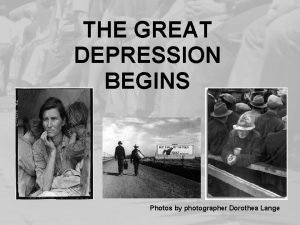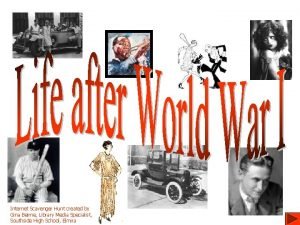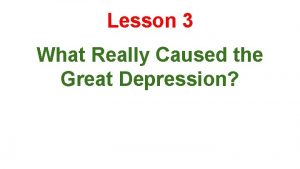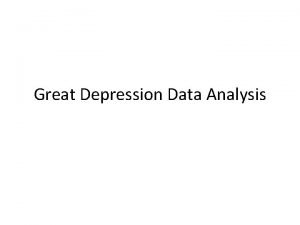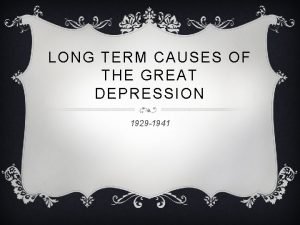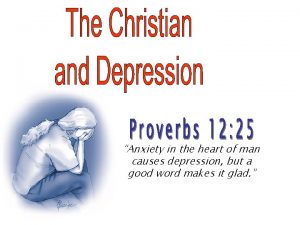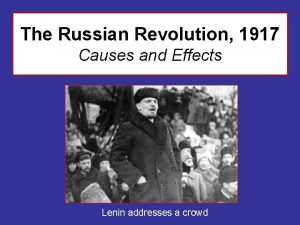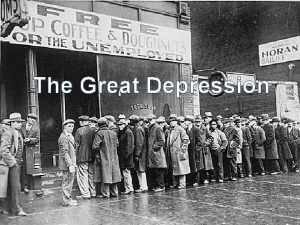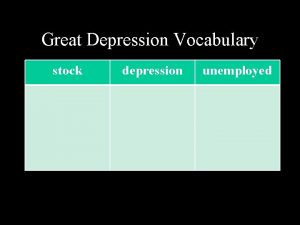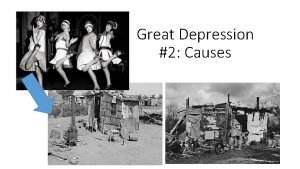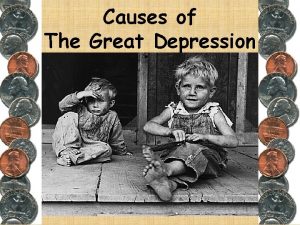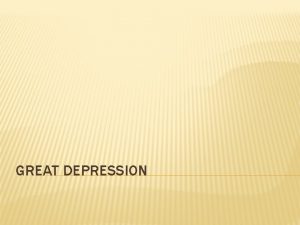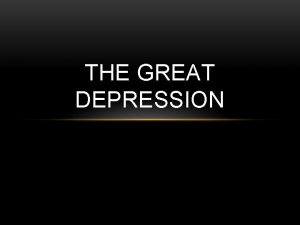THE GREAT DEPRESSION Causes Effects Legacy The Great










- Slides: 10

THE GREAT DEPRESSION Causes, Effects, Legacy

The Great Depression ■ Economic crisis during the 1930 s lasting about 10 years ■ Began in U. S. with subsequent impacts throughout the world ■ Sharp increases in unemployment, poverty, homelessness, farming failures ■ Precipitated innovative recovery measures and legislative protection

The Great Depression ■ Causes – Stock Market Crash of 1929 ■ ■ Rising stock prices during the 1920 s Unregulated market Perceived easy way to make money Borrowing or mortgaging to buy shares – ■ Margin: purchase price financed with loans to be repaid with profits generated by increasing share price Decline of stock prices in October 1929 – – Shareholder panic – rush to liquidate holdings Exacerbated decline in prices and resulted in further panic

The Great Depression ■ Results – Stock Market Crash of 1929 ■ ■ ■ Psychological shock and loss of confidence in the economy Consumer spending declined Business investment reduced Reduced industrial production Job losses Farmers hit particularly hard – – Declining prices for farm goods Great Plains ‘Dust Bowl’

The Great Depression ■ Remediation – Change of Presidents ■ Herbert Hoover was President of the United States in 1929 – – – Many blamed Hoover for the Great Depression Shantytowns where homeless lived were called ‘Hoovervilles’ Perceived as ineffective in dealing with the crisis

The Great Depression ■ Remediation – Change of Presidents ■ Franklin D. Roosevelt elected President of the United States in 1932 – Promised the people of America a ‘New Deal’ ■ New Deal: series of laws, programs, and government agencies enacted to help the country deal with the great Depression ■ Placed regulations on the stock market, banks and businesses ■ Many of the measures and laws are still in place today (i. e. Social Security, SEC regulations) ■ The New Deal did not end the Great Depression but alleviated its impacts

The Great Depression ■ Legacy – The Great Depression ended with the start of World War II and the resulting wartime economy ■ New Deal-related legislation increased the role of government in everyday life ■ Efforts of agencies such as Public Works Administration significantly improved the infrastructure of the country with the construction of roads, schools, bridges, parks and airports.

The Great Depression ■ Interesting Facts about the Great Depression – Stock market lost 90% of its value between 1929 and 1933 – 11, 000 banks failed during the Great Depression – Unemployment in 1929 was 3%; in 1933 it was 25% – The average family income dropped by 40% during the Great Depression – More than $1 B in bank deposits were lost due to bank failures/closures – The New Deal created about 100 new government offices and 40 new agencies – At least 300, 000 companies went out of business – Hundreds of thousands of home foreclosures occurred – Millions migrated from the Dust Bowl Midwest; 200, 000 of those moved to California – President Roosevelt pushed 15 major laws through in his ‘First Hundred Days’ in office

The Great Depression ■ Measuring the Great Depression – Economic Definitions – Consumer Price Index (CPI) is a measure of the average change over time in the prices paid by urban consumers for a market basket of consumer goods and services. – Deflation is a general downward movement of prices for goods and services in an economy. – Depression is a very severe recession; a period of severely declining economic activity spread across the economy (not limited to particular sectors or regions) normally visible in a decline in real GDP, real income, employment, industrial production, wholesale-retail credit and the loss of the overall confidence in the economy.

The Great Depression ■ Measuring the Great Depression – Economic Definitions – Inflation is a general upward movement of prices for goods and services in an economy. . – Nominal Gross Domestic Product (GDP) is the market value of all final goods and services produced within a country in a year. – Real Gross Domestic Product (GDP) is the production of all final goods and services within a country valued at constant prices (i. e. , adjusted for inflation or deflation). – Unemployment rate is the percentage of the labor force who are unemployed.
 Five effects of the great depression
Five effects of the great depression Five effects of the great depression
Five effects of the great depression Five effects of the great depression
Five effects of the great depression Great depression budget activity
Great depression budget activity Great depression causes
Great depression causes What were the long term causes of the great depression
What were the long term causes of the great depression Asymmetric dimethylarginine
Asymmetric dimethylarginine Tennessee valley authority new deal
Tennessee valley authority new deal Anxiety in the heart of man causes depression
Anxiety in the heart of man causes depression Causes and effects of the russian revolution
Causes and effects of the russian revolution Causes and effects of french revolution
Causes and effects of french revolution

